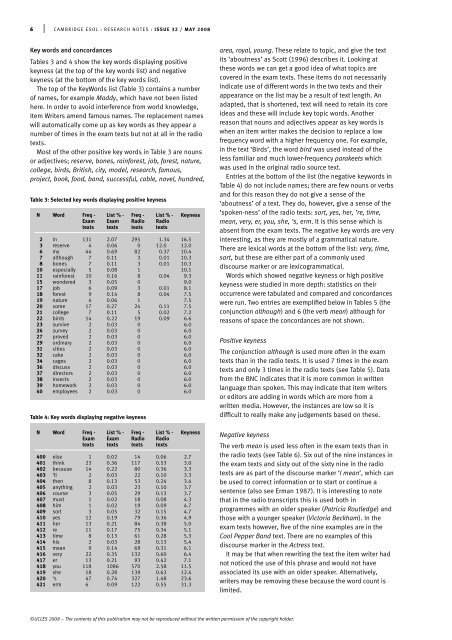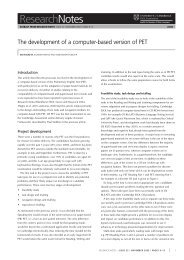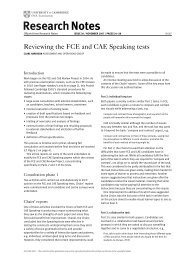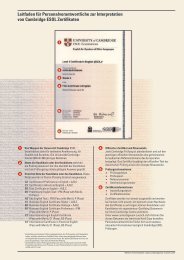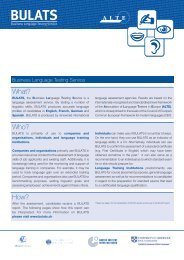Vocabulary use in the FCE Listening test - Cambridge English Exams
Vocabulary use in the FCE Listening test - Cambridge English Exams
Vocabulary use in the FCE Listening test - Cambridge English Exams
You also want an ePaper? Increase the reach of your titles
YUMPU automatically turns print PDFs into web optimized ePapers that Google loves.
6 | CAMBRIDGE ESOL : RESEARCH NOTES : ISSUE 32 / MAY 2008Key words and concordancesTables 3 and 4 show <strong>the</strong> key words display<strong>in</strong>g positivekeyness (at <strong>the</strong> top of <strong>the</strong> key words list) and negativekeyness (at <strong>the</strong> bottom of <strong>the</strong> key words list).The top of <strong>the</strong> KeyWords list (Table 3) conta<strong>in</strong>s a numberof names, for example Maddy, which have not been listedhere. In order to avoid <strong>in</strong>terference from world knowledge,Item Writers amend famous names. The replacement nameswill automatically come up as key words as <strong>the</strong>y appear anumber of times <strong>in</strong> <strong>the</strong> exam texts but not at all <strong>in</strong> <strong>the</strong> radiotexts.Most of <strong>the</strong> o<strong>the</strong>r positive key words <strong>in</strong> Table 3 are nounsor adjectives; reserve, bones, ra<strong>in</strong>forest, job, forest, nature,college, birds, British, city, model, research, famous,project, book, food, band, successful, cable, novel, hundred,Table 3: Selected key words display<strong>in</strong>g positive keynessN Word Freq - List % - Freq - List % - KeynessExam Exam Radio Radiotexts texts texts texts2 <strong>in</strong> 131 2.07 295 1.34 16.53 reserve 4 0.06 0 12.0 12.06 my 44 0.69 82 0.37 10.47 although 7 0.11 3 0.01 10.38 bones 7 0.11 3 0.01 10.310 especially 5 0.08 1 10.111 ra<strong>in</strong>forest 10 0.16 8 0.04 9.315 wondered 3 0.05 0 9.017 job 6 0.09 3 0.01 8.118 forest 9 0.14 8 0.04 7.519 nature 4 0.06 1 7.520 some 17 0.27 24 0.11 7.521 college 7 0.11 5 0.02 7.222 birds 14 0.22 19 0.09 6.623 survive 2 0.03 0 6.026 survey 2 0.03 0 6.027 proved 2 0.03 0 6.029 ord<strong>in</strong>ary 2 0.03 0 6.031 cities 2 0.03 0 6.032 cake 2 0.03 0 6.034 cages 2 0.03 0 6.036 discuss 2 0.03 0 6.037 directors 2 0.03 0 6.038 <strong>in</strong>sects 2 0.03 0 6.039 homework 2 0.03 0 6.040 employees 2 0.03 0 6.0Table 4: Key words display<strong>in</strong>g negative keynessN Word Freq - List % - Freq - List % - KeynessExam Exam Radio Radiotexts texts texts texts400 else 1 0.02 14 0.06 2.7401 th<strong>in</strong>k 23 0.36 117 0.53 3.0402 beca<strong>use</strong> 14 0.22 80 0.36 3.3403 ‘ll 2 0.03 22 0.10 3.3404 <strong>the</strong>n 8 0.13 53 0.24 3.4405 anyth<strong>in</strong>g2 0.03 23 0.10 3.7406 course 3 0.05 29 0.13 3.7407 must 1 0.02 18 0.08 4.3408 him 1 0.02 19 0.09 4.7409 sort 3 0.05 32 0.15 4.7410 yes 12 0.19 79 0.36 4.9411 her 13 0.21 84 0.38 5.0412 re 11 0.17 75 0.34 5.1413 time 8 0.13 61 0.28 5.3414 his 2 0.03 28 0.13 5.4415 mean 9 0.14 69 0.31 6.1416 very 22 0.35 132 0.60 6.4417 er 13 0.21 93 0.42 7.1418 you 118 1086 570 2.58 11.5419 she 18 0.28 139 0.63 12.4420 ‘s 47 0.74 327 1.48 23.6421 erm 6 0.09 122 0.55 31.3area, royal, young. These relate to topic, and give <strong>the</strong> textits ‘aboutness’ as Scott (1996) describes it. Look<strong>in</strong>g at<strong>the</strong>se words we can get a good idea of what topics arecovered <strong>in</strong> <strong>the</strong> exam texts. These items do not necessarily<strong>in</strong>dicate <strong>use</strong> of different words <strong>in</strong> <strong>the</strong> two texts and <strong>the</strong>irappearance on <strong>the</strong> list may be a result of text length. Anadapted, that is shortened, text will need to reta<strong>in</strong> its coreideas and <strong>the</strong>se will <strong>in</strong>clude key topic words. Ano<strong>the</strong>rreason that nouns and adjectives appear as key words iswhen an item writer makes <strong>the</strong> decision to replace a lowfrequency word with a higher frequency one. For example,<strong>in</strong> <strong>the</strong> text ‘Birds’, <strong>the</strong> word bird was <strong>use</strong>d <strong>in</strong>stead of <strong>the</strong>less familiar and much lower-frequency parakeets whichwas <strong>use</strong>d <strong>in</strong> <strong>the</strong> orig<strong>in</strong>al radio source text.Entries at <strong>the</strong> bottom of <strong>the</strong> list (<strong>the</strong> negative keywords <strong>in</strong>Table 4) do not <strong>in</strong>clude names; <strong>the</strong>re are few nouns or verbsand for this reason <strong>the</strong>y do not give a sense of <strong>the</strong>‘aboutness’ of a text. They do, however, give a sense of <strong>the</strong>‘spoken-ness’ of <strong>the</strong> radio texts: sort, yes, her, ’re, time,mean, very, er, you, she, ‘s, erm. It is this sense which isabsent from <strong>the</strong> exam texts. The negative key words are very<strong>in</strong>terest<strong>in</strong>g, as <strong>the</strong>y are mostly of a grammatical nature.There are lexical words at <strong>the</strong> bottom of <strong>the</strong> list: very, time,sort, but <strong>the</strong>se are ei<strong>the</strong>r part of a commonly <strong>use</strong>ddiscourse marker or are lexicogrammatical.Words which showed negative keyness or high positivekeyness were studied <strong>in</strong> more depth: statistics on <strong>the</strong>iroccurrence were tabulated and compared and concordanceswere run. Two entries are exemplified below <strong>in</strong> Tables 5 (<strong>the</strong>conjunction although) and 6 (<strong>the</strong> verb mean) although forreasons of space <strong>the</strong> concordances are not shown.Positive keynessThe conjunction although is <strong>use</strong>d more often <strong>in</strong> <strong>the</strong> examtexts than <strong>in</strong> <strong>the</strong> radio texts. It is <strong>use</strong>d 7 times <strong>in</strong> <strong>the</strong> examtexts and only 3 times <strong>in</strong> <strong>the</strong> radio texts (see Table 5). Datafrom <strong>the</strong> BNC <strong>in</strong>dicates that it is more common <strong>in</strong> writtenlanguage than spoken. This may <strong>in</strong>dicate that item writersor editors are add<strong>in</strong>g <strong>in</strong> words which are more from awritten media. However, <strong>the</strong> <strong>in</strong>stances are low so it isdifficult to really make any judgements based on <strong>the</strong>se.Negative keynessThe verb mean is <strong>use</strong>d less often <strong>in</strong> <strong>the</strong> exam texts than <strong>in</strong><strong>the</strong> radio texts (see Table 6). Six out of <strong>the</strong> n<strong>in</strong>e <strong>in</strong>stances <strong>in</strong><strong>the</strong> exam texts and sixty out of <strong>the</strong> sixty n<strong>in</strong>e <strong>in</strong> <strong>the</strong> radiotexts are as part of <strong>the</strong> discourse marker ‘I mean’, which canbe <strong>use</strong>d to correct <strong>in</strong>formation or to start or cont<strong>in</strong>ue asentence (also see Erman 1987). It is <strong>in</strong>terest<strong>in</strong>g to notethat <strong>in</strong> <strong>the</strong> radio transcripts this is <strong>use</strong>d both <strong>in</strong>programmes with an older speaker (Patricia Routledge) andthose with a younger speaker (Victoria Beckham). In <strong>the</strong>exam texts however, five of <strong>the</strong> n<strong>in</strong>e examples are <strong>in</strong> <strong>the</strong>Cool Pepper Band text. There are no examples of thisdiscourse marker <strong>in</strong> <strong>the</strong> Actress text.It may be that when rewrit<strong>in</strong>g <strong>the</strong> text <strong>the</strong> item writer hadnot noticed <strong>the</strong> <strong>use</strong> of this phrase and would not haveassociated its <strong>use</strong> with an older speaker. Alternatively,writers may be remov<strong>in</strong>g <strong>the</strong>se beca<strong>use</strong> <strong>the</strong> word count islimited.©UCLES 2008 – The contents of this publication may not be reproduced without <strong>the</strong> written permission of <strong>the</strong> copyright holder.


